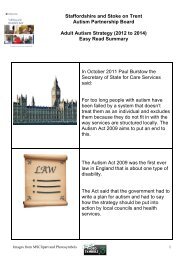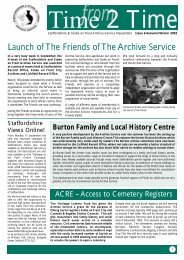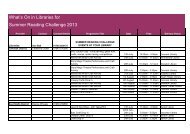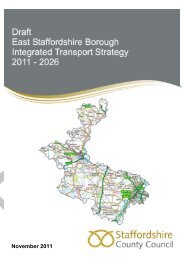nationalCommunitySafetyPlan200811 - Staffordshire County Council
nationalCommunitySafetyPlan200811 - Staffordshire County Council
nationalCommunitySafetyPlan200811 - Staffordshire County Council
Create successful ePaper yourself
Turn your PDF publications into a flip-book with our unique Google optimized e-Paper software.
8 NATIONAL COMMUNITY SAFETY PLAN 2008–11<br />
3. DELIVERING THE GOVERNMENT’S COMMUNITY SAFETY<br />
OBJECTIVES: KEY POLICIES AND PROGRAMMES, AND<br />
WHAT THEY MEAN FOR PARTNERSHIPS<br />
MAKE COMMUNITIES SAFER (PSA 23)<br />
PRIORITY ACTION 1: REDUCE THE MOST<br />
SERIOUS VIOLENCE<br />
The most harmful crimes are undeniably those<br />
in which people are killed, seriously injured and/<br />
or seriously psychologically harmed. Protecting<br />
the public begins with tackling these most serious<br />
offences. Given the nature of these crimes, although<br />
specifi c local challenges will vary, all local agencies<br />
in every area can be expected to prioritise efforts to<br />
tackle serious violence.<br />
What does it mean for the public?<br />
The public will see a reduction nationally in the<br />
prevalence of serious violent crimes over a sustained<br />
period. This includes:<br />
■ a reduction in the number of murders, attempted<br />
murders and serious violent assaults (including<br />
those that are gang related);<br />
■ a reduction in gun and knife crime;<br />
■ a more effective and appropriate response by police,<br />
criminal justice agencies and other partners to<br />
incidents of domestic violence and serious sexual<br />
violence (including ensuring appropriate support<br />
for victims);<br />
■ a reduction in deaths and serious injuries on our<br />
roads, especially as a result of the most serious<br />
offences (e.g. drink driving, speeding or driving<br />
while disqualifi ed, uninsured or without a licence,<br />
among other offences); and<br />
■ an increase in the conviction rate for rape in the CJS.<br />
What does it mean for partnerships?<br />
Specifi c local targets will not be mandated by the<br />
Government as part of this PSA. However, all local<br />
areas should take into account the relative level<br />
and nature of serious crime experienced within<br />
their locality when considering local priorities. The<br />
performance of partnerships and the police against<br />
this objective will be measured through indicators in<br />
the Assessments of Policing and Community Safety<br />
(APACS) related to violent crime (see section 4 for<br />
further detail on performance management).<br />
In line with local priorities and strategic assessments,<br />
partnerships should consider:<br />
■ identifi cation of and early intervention with victims<br />
and perpetrators of domestic violence, to prevent<br />
escalation, including (in many areas) through<br />
implementation of Multi-Agency Risk Assessment<br />
Conferences (MARACs); 2<br />
■ building on this, developing mechanisms for<br />
identifying and intervening early with those at risk<br />
of involvement in violence, either as a perpetrator<br />
or a victim (informed by work to be taken forward<br />
nationally under the Tackling Violence Action Plan);<br />
■ identifying and targeting the key causes of serious<br />
road casualties in the area, including tackling<br />
accident blackspots;<br />
■ working jointly with LCJBs and Reducing<br />
Reoffending Partnership Boards to develop effective<br />
local responses to tackling serious sexual offences,<br />
including the provision of effective victim care<br />
pathways to minimise harm and action to improve<br />
the investigation and prosecution of serious<br />
sexual offences; 3<br />
■ developing action to tackle hate crime, based on<br />
good practice and in response to local assessment<br />
of need; and<br />
■ in specifi c local areas, implementing the measures<br />
in the Tackling Gangs Action Programme (priority<br />
neighbourhoods in parts of London, Liverpool,<br />
Greater Manchester and Birmingham).<br />
2 Over 100 MARAC areas will have received funding and training by the end of 2007/08, and we are aiming for national roll-out of MARACs by 2010.<br />
3 In some areas this will include the implementation of Sexual Assault Referral Centres (SARCs) – 36 SARCs will be established by the end of 2008/09.

















